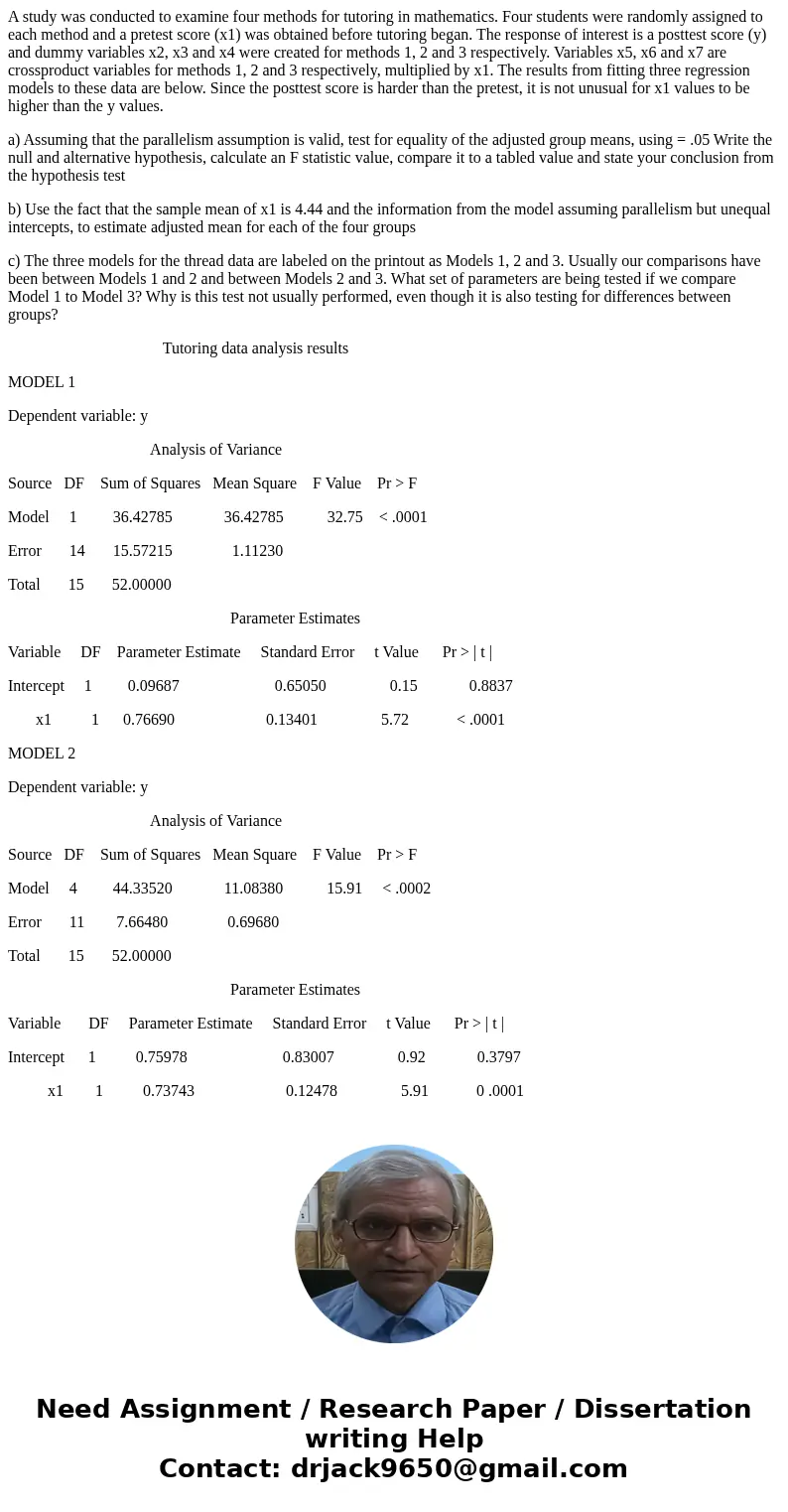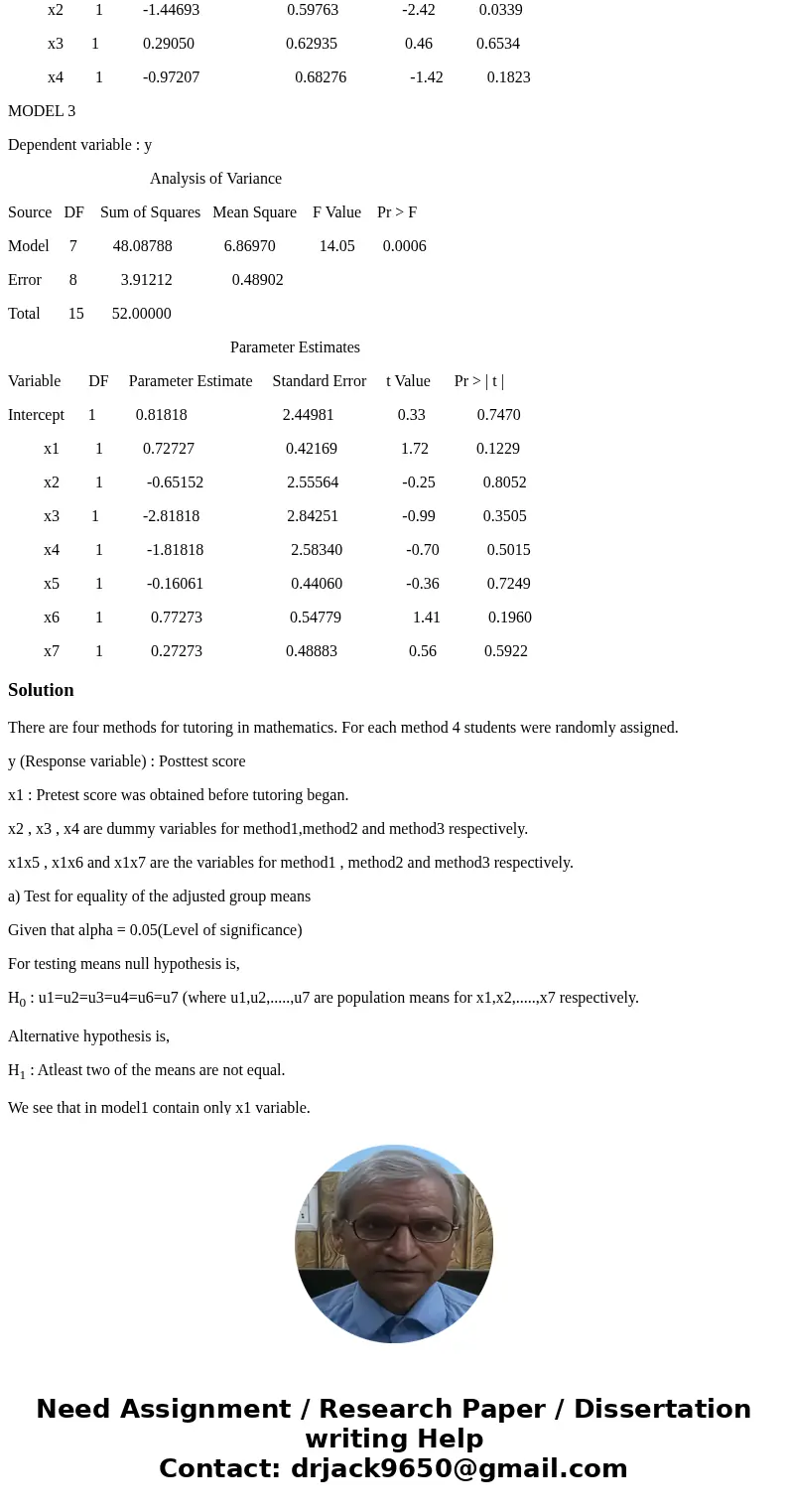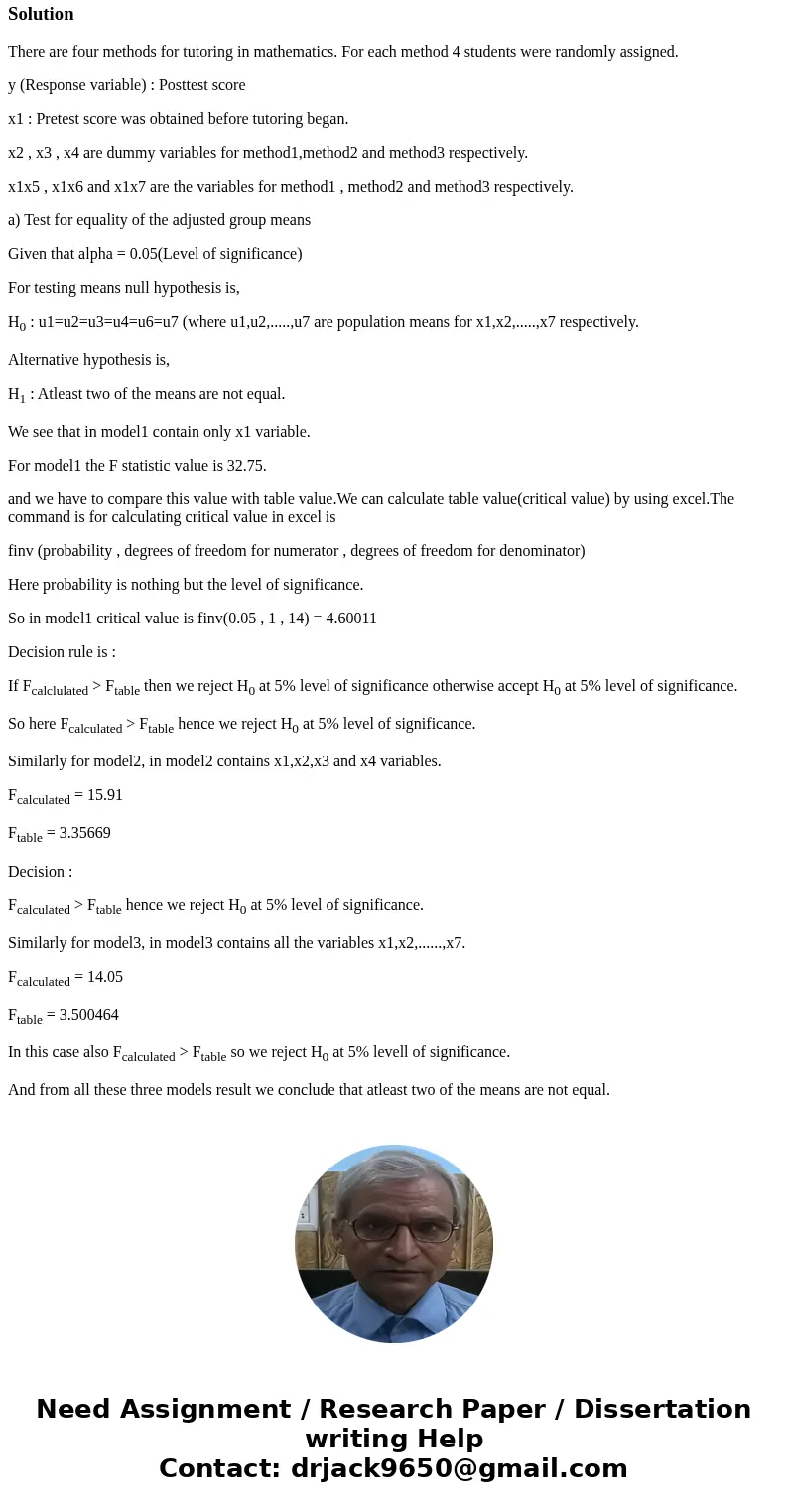A study was conducted to examine four methods for tutoring i
A study was conducted to examine four methods for tutoring in mathematics. Four students were randomly assigned to each method and a pretest score (x1) was obtained before tutoring began. The response of interest is a posttest score (y) and dummy variables x2, x3 and x4 were created for methods 1, 2 and 3 respectively. Variables x5, x6 and x7 are crossproduct variables for methods 1, 2 and 3 respectively, multiplied by x1. The results from fitting three regression models to these data are below. Since the posttest score is harder than the pretest, it is not unusual for x1 values to be higher than the y values.
a) Assuming that the parallelism assumption is valid, test for equality of the adjusted group means, using = .05 Write the null and alternative hypothesis, calculate an F statistic value, compare it to a tabled value and state your conclusion from the hypothesis test
b) Use the fact that the sample mean of x1 is 4.44 and the information from the model assuming parallelism but unequal intercepts, to estimate adjusted mean for each of the four groups
c) The three models for the thread data are labeled on the printout as Models 1, 2 and 3. Usually our comparisons have been between Models 1 and 2 and between Models 2 and 3. What set of parameters are being tested if we compare Model 1 to Model 3? Why is this test not usually performed, even though it is also testing for differences between groups?
Tutoring data analysis results
MODEL 1
Dependent variable: y
Analysis of Variance
Source DF Sum of Squares Mean Square F Value Pr > F
Model 1 36.42785 36.42785 32.75 < .0001
Error 14 15.57215 1.11230
Total 15 52.00000
Parameter Estimates
Variable DF Parameter Estimate Standard Error t Value Pr > | t |
Intercept 1 0.09687 0.65050 0.15 0.8837
x1 1 0.76690 0.13401 5.72 < .0001
MODEL 2
Dependent variable: y
Analysis of Variance
Source DF Sum of Squares Mean Square F Value Pr > F
Model 4 44.33520 11.08380 15.91 < .0002
Error 11 7.66480 0.69680
Total 15 52.00000
Parameter Estimates
Variable DF Parameter Estimate Standard Error t Value Pr > | t |
Intercept 1 0.75978 0.83007 0.92 0.3797
x1 1 0.73743 0.12478 5.91 0 .0001
x2 1 -1.44693 0.59763 -2.42 0.0339
x3 1 0.29050 0.62935 0.46 0.6534
x4 1 -0.97207 0.68276 -1.42 0.1823
MODEL 3
Dependent variable : y
Analysis of Variance
Source DF Sum of Squares Mean Square F Value Pr > F
Model 7 48.08788 6.86970 14.05 0.0006
Error 8 3.91212 0.48902
Total 15 52.00000
Parameter Estimates
Variable DF Parameter Estimate Standard Error t Value Pr > | t |
Intercept 1 0.81818 2.44981 0.33 0.7470
x1 1 0.72727 0.42169 1.72 0.1229
x2 1 -0.65152 2.55564 -0.25 0.8052
x3 1 -2.81818 2.84251 -0.99 0.3505
x4 1 -1.81818 2.58340 -0.70 0.5015
x5 1 -0.16061 0.44060 -0.36 0.7249
x6 1 0.77273 0.54779 1.41 0.1960
x7 1 0.27273 0.48883 0.56 0.5922
Solution
There are four methods for tutoring in mathematics. For each method 4 students were randomly assigned.
y (Response variable) : Posttest score
x1 : Pretest score was obtained before tutoring began.
x2 , x3 , x4 are dummy variables for method1,method2 and method3 respectively.
x1x5 , x1x6 and x1x7 are the variables for method1 , method2 and method3 respectively.
a) Test for equality of the adjusted group means
Given that alpha = 0.05(Level of significance)
For testing means null hypothesis is,
H0 : u1=u2=u3=u4=u6=u7 (where u1,u2,.....,u7 are population means for x1,x2,.....,x7 respectively.
Alternative hypothesis is,
H1 : Atleast two of the means are not equal.
We see that in model1 contain only x1 variable.
For model1 the F statistic value is 32.75.
and we have to compare this value with table value.We can calculate table value(critical value) by using excel.The command is for calculating critical value in excel is
finv (probability , degrees of freedom for numerator , degrees of freedom for denominator)
Here probability is nothing but the level of significance.
So in model1 critical value is finv(0.05 , 1 , 14) = 4.60011
Decision rule is :
If Fcalclulated > Ftable then we reject H0 at 5% level of significance otherwise accept H0 at 5% level of significance.
So here Fcalculated > Ftable hence we reject H0 at 5% level of significance.
Similarly for model2, in model2 contains x1,x2,x3 and x4 variables.
Fcalculated = 15.91
Ftable = 3.35669
Decision :
Fcalculated > Ftable hence we reject H0 at 5% level of significance.
Similarly for model3, in model3 contains all the variables x1,x2,......,x7.
Fcalculated = 14.05
Ftable = 3.500464
In this case also Fcalculated > Ftable so we reject H0 at 5% levell of significance.
And from all these three models result we conclude that atleast two of the means are not equal.



 Homework Sourse
Homework Sourse